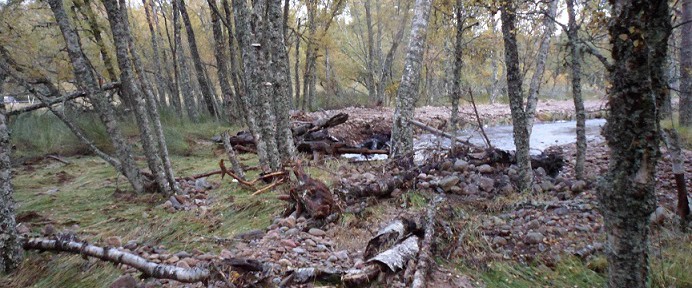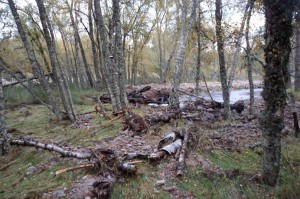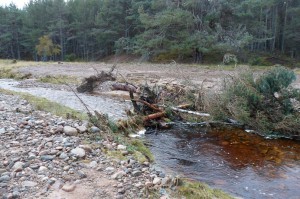
Two months ago I made a journey down to the Tweed Catchment to see Natural Flood Management measures put in place by the Tweed Forum, which became my first blog post on here. Since then I have been developing my project on the Allan Water and I have started to meet land owners and land managers on my catchment to discuss what type of NFM measure/s would apply to their land and businesses, and where these measure/s could be applied. The next step in the process of getting NFM measures in place, requires getting money through rural development grants i.e the Government, which can be a complex process.
Thankfully Hugh Chalmers of the Tweed Forum was available yesterday, and invited me down to go through the rural development grant application process. Hugh also suggested visiting a subcatchment I didn’t see on the previous trip, which recently had a new NFM measure put in place! After a couple of rounds of tea with Hugh, some in depth explaining and a frazzled brain, I felt I had acquired a good understanding of the rural development grant process and was a lot more comfortable in my knowledge of how to apply for funding.
Therefore, with that achieved, it was time to get out of the Tweed Forum office and into the fresh air, blue skies and tropical 21.5oC of the Tweed catchment to visit the Eddleston sub-catchment. The Eddleston is a well monitored tributary of the Tweed and has it’s own project (see link at the very bottom) where the Tweed Forum and University of Dundee collaborate to monitor the river and aim to provide the evidence of how effective certain NFM measures are.
Unfortunately I am currently camera-less after taking it along the Allan Water on a rainy day. However, thankfully I do have photographs of similar NFM measures that I can use as visual aids.
Two of the sites we visited on the Eddelston had been planted with riparian native woodland in February, which comprised a mix of alder, birch, willow, aspen, oak and rowan to name a few. Hugh gave me some great tree planting advice at these sites, particularly about maintenance and grazer protection, which will come in very useful for future projects on the Allan Water. The riparian tree sites will hopefully establish themselves into woodlands, similar to the native riparian birch woodland I pictured in the Spey Catchment below. Riparian trees are planted to slow the flow of flood water, If you look on the ground beneath the trees you will see a lot of gravel and woody debris has been deposited, this is due to these trees slowing the water flow down during the last flood, evidence of their efficiency!
The other NFM measure we visited, and the newest on the Eddleston sub-catchment was log jams, which had only been put in place 7 days previous to my visit. Log jams can be used in a variety of ways, such as sediment trapping/bar forming, influence meandering or in this case they were used as a leaky barrier to hold back water in a small burn that can flash flood. The idea behind the log jams is that they will make the burn drain it’s rain water slowly instead of getting rid of it in a very short period of time. Therefore the burn will contribute far less to the main river flood peak that causes the most damage. Once again, my log jam picture below comes from the Spey Catchment. The log jam in the picture is not too dissimilar from the ones installed on the Eddleston, but this one is used to influence the river to meander by letting the water flow through one side of the log jam but not the other.
It was a productive and very useful trip to the Tweed that had a good mix of grant funding education and NFM site visits. I’ll get the issue with my camera sorted before my next blog!
Eddleston water Project: http://www.sepa.org.uk/flooding/flood_risk_management/working_with_nature/the_eddleston_water_project.aspx


